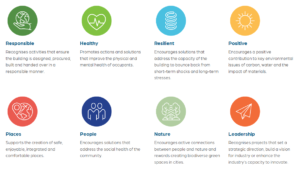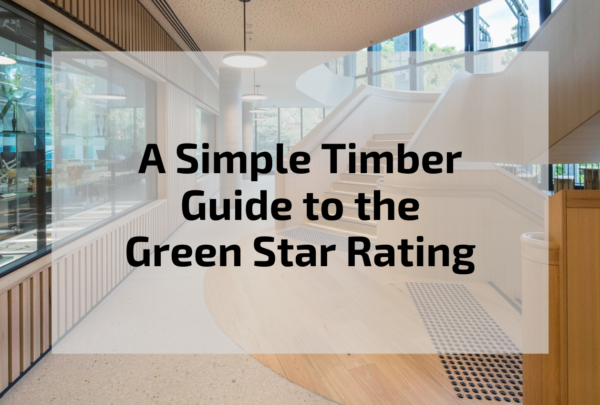Launched by the Green Building Council of Australia (GBCA) in 2003, Green Star is Australia’s largest voluntary and holistic sustainability rating system for buildings, fit outs and communities. Green Star buildings are cutting greenhouse gas emissions, showing significant reduction in energy and water consumption, and preventing truckloads of waste going to landfill.
There are many benefits beyond the Green Star like a reduction in operational costs and an increase in property value. According to the GBCA, Green Star buildings consume 66% less electricity and 51% less portable water than the average Australian building. It is also said that Green Star-rated office buildings deliver a 4.3% ‘green premium’ at the time of sale, a 13% higher return and 56% lower vacancy rate. It’s no wonder why Green Star is growing in popularity as many strive to achieve this rating on their projects.
Throughout this blog we’ll be outlining the basic process of receiving a Green Star rating and the many reasons why using timber can benefit your next build. So if you’re curious, read on!
The Green Star rating is an independent verification that provides assurance that a project meets high standards across a range of sustainability categories. Certified projects can also proudly display the Green Star Certification Trademark.
The aim of Green Star is to transform the way our built environment is designed, constructed and operated by:
Building operations assessed using the Green Star ‘Performance’ rating tool can achieve a Green Star rating of 1 – 6 Stars. Green Star ‘Buildings’ (previously ‘As Design & Built’), ‘Interiors’ and ‘Communities’ certified projects can achieve a Green Star rating of 4 – 6 Stars.

Green Star is becoming more common throughout the community and has shaped many projects. The GBCA has issued over 2,800 Green Star certifications with:
Each Green Star rating tool has its own set of categories and credits. In this section we will be looking at the Green Star Buildings rating tool, which is specific to the design and construction of new buildings and major refurbishments.
The aim of Green Star Buildings is to deliver healthy, resilient, and positive places for people and nature as well as meet current and future demands on the built environment. This rating tool factors 5 key components:
1. Delivers a new definition of a sustainable building. This component outlines 8 categories that represent the issues the built environment will face in the next decade.

2. Meets the Paris Agreement. An aim of Green Star Buildings is to drive all buildings to be net zero carbon in operations through both operational and embodied carbon emissions. The goal is to ensure that all new Australian buildings are net zero carbon in operations from 2030 onwards. This includes being fossil fuel free, powered by renewables, highly efficient, built with lower upfront emissions and offset with nature.
3. Responds to sustainability megatrends. The Green Star Building is designed to consider the impacts against the key megatrends of the next decade to ensure it can respond to the strategic goals of governments, tenants, investors, developers and building owners.
4. Creates clear expectations for new buildings. To assist in making the rating tool understandable for everyone, all Green Star Building projects meet 10 minimum expectations:
Futhermore, 6 Star rated buildings are expected to be fossil fuel free, highly efficient buildings, powered by renewables, and built with low carbon materials.
5. Delivers opportunities for supply chain transformation. Green Star Buildings wants to increase market demand for innovative, responsible, and low carbon products. This can be done by rewarding products that have lower environmental impact, are transparent, respect human rights, and are lower in carbon content and creating a driver for low carbon products by introducing a requirement that must be met to reduce their embodied carbon to achieve a rating.
A 4 Star rated building is considered a best practice environmental performer. All 4 Star Green Star rated buildings must meet the 10 minimum expectations, plus meet one of the following: a higher performer in energy, water, and health related issues (15 out of 100 points) or on a climate positive pathway. The climate positive pathway is a recently reviewed expectation that requires projects to be highly efficient, free of fossil fuels, powered by renewables and built using low carbon materials.

A 5 Star rated building demonstrates Australian excellence by being a high environmental performer. All 5 Star rated buildings must meet the 10 minimum expectations, plus meet one of the following: be a higher performer in energy, water, and health related issues (35 out of 100 points) or on a climate positive pathway plus 20 points.

This achievement showcases world leadership and is reserved for highly efficient buildings fully powered by renewables. All 6 Star rated buildings must meet the 10 minimum expectations and a significant number of social and environmental issues (70 out of 100 points) which includes a climate positive pathway.

Learn more about the expectations for 4, 5 and 6 Green Star buildings here.
There are a number of environmental benefits of Green Star buildings – they produce fewer greenhouse gas emissions, use less electricity, use less portable water and recycle 96% of construction and demolition waste. Green Star-rated buildings have reduced electricity consumption by 580,000 megawatts per year, which is the equivalent to the average annual electricity use of 76,000 households. On average, Green Star-certified buildings produce 62% fewer greenhouse gas emissions, use 66% less electricity and 51% less potable water than average buildings.
Green Star buildings have lower operational costs by consuming less energy and water, increasing productivity, morale, employee retention and increasing the value of the property. The largest Green Star fitout in the country, ANZ’s headquarters in Melbourne, saves approximately $200,000 in costs annually. Fujitsu have seen a 42% fall in absenteeism since moving its staff into a Green Star-rated headquarters in Melbourne and productivity has shot up by 15% for multiple staff groups at Macquarie Bank’s 6 Star Green Star office in Sydney.
The Green Star rating system acknowledges the use of timber from recognised product certification schemes or initiatives under the Responsible Products Framework. Most ASH products are recognised under the Responsible Wood Certification Scheme, Responsible Wood is the Australian National Governing Body for PEFC, the world’s largest forest certification system. In December 2021, Responsible Wood published the new AS/NZS 4708:2021 – Sustainable Forest Management (SFM) standard.
Under the Responsible Products Framework, the use of specific timber products can contribute to credits in Green Star Buildings from 3 out of the 4 main areas; Responsible Structure, Responsible Envelope and Responsible Finishes. And can be recognised under two performance levels: ‘Good Practice’ or ‘Best Practice’. For more information or to understand which of our products can contribute to ‘Best Practice’ performance, get in touch with our friendly team here.

There are a number of other credits that are positively impacted by the use of timber including; Responsible Procurement, Exposure to Toxins, Upfront Carbon Emissions, Lifecycle Impacts and Circular Economy. These credits encourage the use of responsible, healthy, positive, and circular products. Click here for more information or head to the GBCA website.

A prime example of a Green Star rated building is the University of Melbourne Life Sciences Precinct (UoM) which is the University’s second 6 Star (‘Design & As Built’ which is now recognised as ‘Buildings’ for newer projects) building and its first scientific building to achieve this rating. The passive design features airtight construction, a high performing glass façade, an advanced rainwater and irrigation system, as well as a solar panel system that generates 33% of the building’s energy usage.
Curated by the team at HASSELL, the UoM Life Sciences building features Australian Oak engineered flooring, along with PEFC certified GoodWood Victorian ash and IronAsh. Timber makes up a significant portion of the build to include elements of biophilic design and add to the Green Star rating.
There are many reasons for designing a Green Star rated building; it promotes a number of environmental, sustainability and financial advantages through the reduction of climate change, the enhancement of health & quality of life and contribution to a sustainable economy. As a local supplier of products that can contribute to a Green Star rating, this system is an excellent incentive to support the use of timber for sustainable design and construction.
"*" indicates required fields
